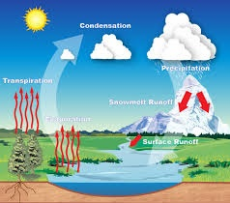
Email: ZYVC057@live.rhul.ac.uk
Total Article : 213
About Me:I'm a graduate student studying International Criminal Law and first started writing for King's News almost 4 years ago! My hobbies include reading, travelling and charity work. I cover many categories but my favourite articles to write are about mysteries of the ancient world, interesting places to visit, the Italian language and animals!

How much water do you use a day? Have you ever wondered where the water in our glass comes from? You may have already learnt about the water cycle at school but if you haven’t this article will walk you through the movement of water below, above and on the surface of the Earth before it ends up in your glass!
You may be surprised to read that about 60% of the human body is made of water! In fact all our vital organs such as the liver, the brain, the lungs and the heart contain water and billions of our cells (the smallest of living things) need water in order to continue living so we constantly drink water to keep our body hydrated. Water covers around 71% of the surface of the Earth and is formed by one oxygen and two hydrogen atoms (the building blocks of matter) linked together. Over 90% of water is salt water is undrinkable; this water is found in the sea and the process of removing salt from the water is far too expensive to use which is why the water cycle is so important.
The water cycle (also known as the hydrologic cycle) consists in the following phases:
* Evaporation and transpiration
* Condensation
* Precipitation
* Collection
Phase 1 – Evaporation and transpiration
Heat from the sun causes water in lakes or oceans to evaporate (turn from liquid to gas) and go in the sky where the vapour forms clouds. Plants transpire similarly to how humans sweat: the heat causes water to evaporate from the leaves of plants and the process of transportation helps get even more water vapour into the air. Both processes combined are known as ‘evapotranspiration’.
Phase 2 – Condensation
The water vapour in the air cools down and turns back into water again in a process called condensation. Now the water is back in its liquid form.
Phase 3 – Precipitation
When so much water has been formed and the cloud gets ‘heavy’ the water precipitates (falls) from the sky as rain, hail or snow.
Phase 4 – Collection
When the water falls down it can either go in rivers, oceans and lakes or it soaks in the Earth’s soil and is used as drinking water for plants and animals. Now that the water is safely back on the Earth’s surface it is ready to evaporate once again as the cycle of water goes on and on.
Additional word: SUBLIMATION
Sublimation is when a solid transforms directly into a gas without being in a liquid form first. Dry ice can sublime at regular air temperature and in some cases snow and ice are able to sublime too!

0 Comment:
Be the first one to comment on this article.